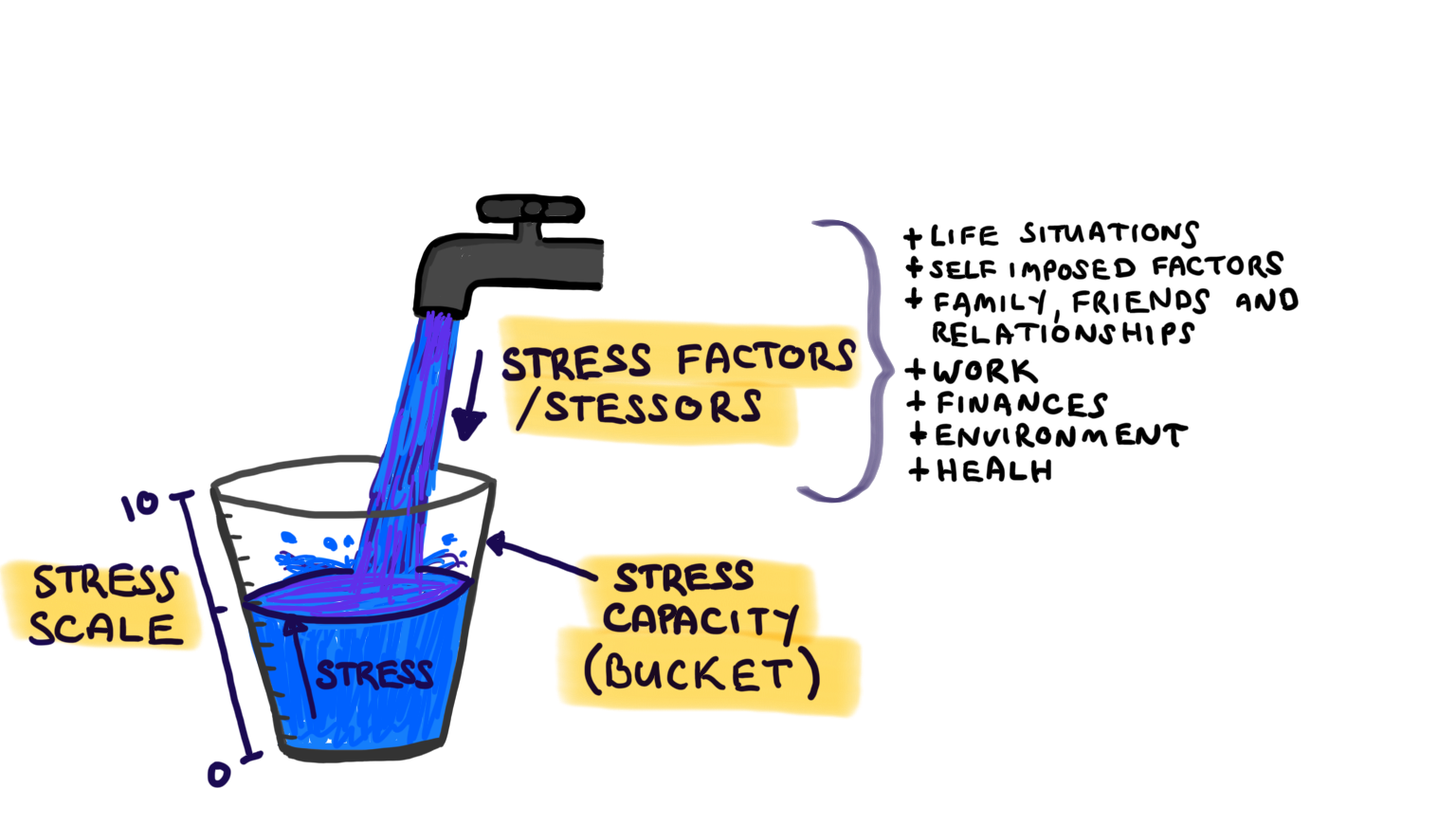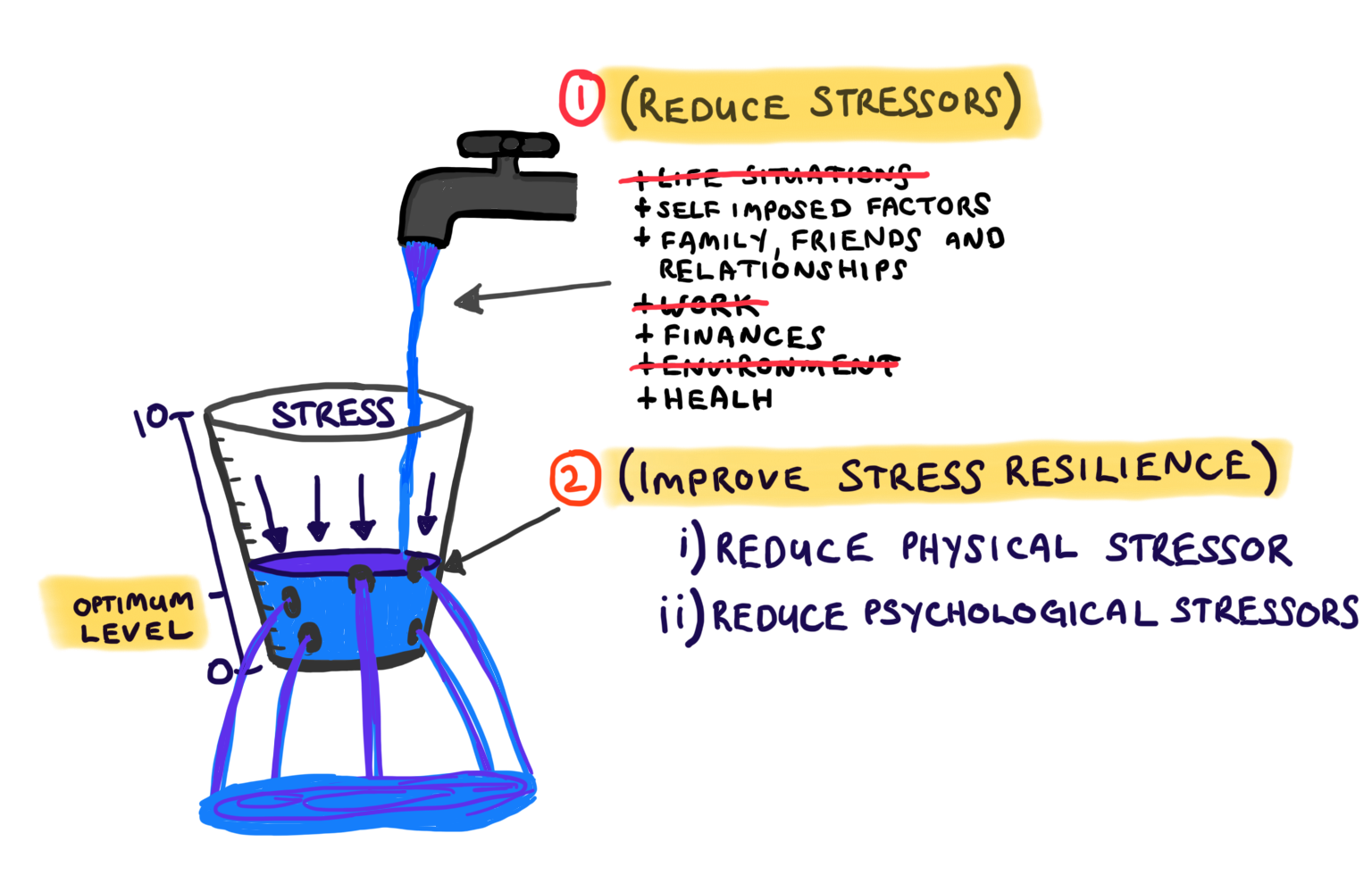Stress management and resilience
Seeking the path to entrepreneurship and fortune comes hand-in-hand with high demands, long working hours and relationship pressures, which if not managed effectively can lead to high levels of stress. If you are looking to enter this journey or deeply engulfed already, it is important that you understand the elements of stress and what actions you can put in place to help manage high levels during the difficult periods.
Stress defined
Stress can be defined as the physical and mental changes we experience as a result of the demands placed on us in our day to day lives. It can be caused by a single element or bound together by many small fragments. Stress can be difficult to identify and and often only recognised when it is too late.
Measuring Stress
A common way to measure stress is on a scale of 1-10 and can be represented using a bell chart (Stress Vs Performance). Too little stress (1-2) and we can easily become lazy and unmotivated, yet too much stress (8-10) can lead to overload and burnout. As human beings, certain levels of stress can be good for us as it can help us to reach our peak performance levels under various situations.
Stress Scale
(1.0)
The issues typically occur when our body is under moderate levels of stress for extended periods and/or peaking too high on the stress scale at any one time, which our mind and body may be unable to manage effectively.
Explaining stress
The best way experts will explain stress is through the ‘Stress Bucket’ analogy (see image 2.1 and 2.2 below).
1. Imagine a bucket, which represents our ‘stress capacity’. The size of our buckets will vary between individuals depending on our resilience and natural ability to cope with stress.
2. The flow of water from a tap into the bucket represents ‘stress factors/Stressors’ entering our lives. The more stress factors we have, the faster the flow of water and the higher and faster the water level will rise. Stress can come from some of the below sources:
- Life situations – moving houses, having a baby, starting a new job, etc;
- Self-imposed factors – negative attitude, drugs consumption, etc;
- Family, friends and relationships – Although these can be a source of joy, they can also place us under stress;
- Work – high workload, lack of flexibility and toxic workplace relationships;
- Finances – mortgage, bills, family expenses, etc;
- Environment – weather, events you see or read in the media, and
- Health – illness, weight level, poor diet, injuries, disabilities, etc.
3. The water level in the bucket represents our ‘stress levels’ on a scale of 1-10 as described above. When our buckets get too full and overflow, it indicates that we have too much stress in our lives and will not be able to cope – anxiety, depression, anger, frustration, volatile moods, breakdown, etc.
Managing stress
There are two major ways to improve your overall stress position, 1. Reduce the number of stress elements in your life, or 2. Improving your overall resilience to stress.
1. Reduce the amount of stress in your bucket
By removing or improving stress factors/stressors in your life (identified at point 2.) you will turn down the tap, slowing down the flow of water and the time taken for your bucket to overflow. You can manage the water level in your bucket (avoiding an overflow) by managing and improving stress resilience.
2. Improving stress resilience
Stress resilience can be improved through various strategies (physical or psychological). Each strategy effectively implemented will put a hole in your bucket allowing water to flow out (managing high-stress levels and overflowing water). The strategy you chose will determine the size of the hole in your bucket, allowing more or less water (stress) to flow out. The more strategies you adopt (stress management tools), the more holes you will have in your bucket to allow greater outflows of water (stress).
Developing good stress resilience habits are essential to your wellbeing and positive mental health.
i) Reduces physical stressors:
Improve sleep quality
Refer to our ‘Sleep to Success‘ article for more direction on this topic.
Improve your nutrition
A healthy diet with minimal amounts of processed foods, appropriate vitamin levels and regular check-ups with your GP.
Manage hydration levels
Refer to our ‘Hydrate to Success’ article for more direction on this topic.
Adequate physical activities
Aim for at least 30 min, 3 times per week. Another option is to measure your ‘daily step levels’, between 7,000 to 10,000 steps per day is a great benchmark.
Manage ‘life’ and ‘self-imposed’ factors
See point 1. and 2.
Improve routine and balance in your life
Our bodies are designed for routine as this helps to reduce unexpected circumstances in our life and less pressure on our mind to deal with these events. Ensure you have routines for your sleep pattern, food and fluid intake and exercise but at the same time keeping these balanced (not too much activity or downtime).
ii) Reduces psychological stressors:
Switch off or let go
If your stressful situation/problem cannot be solved (either right away or into the future), your only option is to manage the worry directly by eliminating it or deferring it into the future. You can do this by distracting or calming the mind and body (see ‘stay relaxed’ below).
Take responsibility
If you are responsible for the situation, which cannot be deferred or let go of, take control of it by dealing and/or managing the situation.
Talk to someone
Talking about your problem can help get it off your chest and allowing for someone else’s perspective on the matter. A problem shared is a problem halved. This can be a family member, friend, mentor, a professional or anonymous person (helpline).
beyondblue aims to increase awareness of depression and anxiety and reduce stigma. Call 1300 22 4636, 24 hours / 7 days a week.
Blue Knot Foundation Helpline (formerly ASCA Professional Support Line) provides help, information, support or referral for adult survivors of childhood trauma and abuse, their partners, family and friends, health professionals and anyone in the workplace working with people who have experienced childhood trauma and abuse. Call 1300 657 380, 9am-5pm AEST / 7 days a week.
Butterfly Foundation’s National Helpline, ED HOPE, is a free, confidential service that provides information, counselling and treatment referral for people with eating disorders, and body image and related issues. Call 1800 33 4673, 8am-midnight AEST / 7 days a week.
eheadspace provides mental health and wellbeing support, information and services to young people aged 12 to 25 years and their families. Call 1800 650 890, 9am-1am AEST / 7 days a week.
Kids Helpline is Australia’s only free 24/7 confidential and private counseling service specifically for children and young people aged 5 to 25. Call 1800 55 1800.
Lifeline provides 24-hour crisis counseling, support groups and suicide prevention services. Call 13 11 14.
MensLine Australia is a professional telephone and online support and information service for Australian men. Call 1300 78 99 78, 24 hours / 7 days a week.
MindSpot is a free telephone and online service for people with stress, worry, anxiety, low mood or depression. It provides online assessment and treatment for anxiety and depression. MindSpot is not an emergency or instant response service. Call 1800 61 44 34 AEST, 8am-8pm (Mon-Fri), 8am-6pm (Sat).
QLife provides nationwide telephone and web-based services to support lesbian, gay, bisexual, transgender and intersex (LGBTI) people of all ages. Call 1800 184 527, 3pm-12am (midnight) AEST / 7 days a week.
PANDA (Perinatal Anxiety & Depression Australia) provides a national telephone information, counselling and referral service staffed by trained volunteers, professional counsellors and supervising staff. Many helpline counsellors have had their own experience of perinatal depression or anxiety. Call 1300 726 306, 9am-7:30pm AEST (Mon-Fri).
SANE Australia provides support, training and education enabling those with a mental illness to lead a better life. Call 1800 18 7263, 10am-10pm AEST (Mon-Fri).
Suicide Call Back Service provides 24/7 support if you or someone you know is feeling suicidal. Call 1300 659 467.
Open Arms — Veterans and Families Counselling provides 24/7 free and confidential, nationwide counselling and support for war and service-related mental health conditions, such as post-traumatic stress disorder (PTSD), anxiety, depression, sleep disturbance and anger. Call 1800 011 046.
Source: https://www.healthdirect.gov.au/mental-health-helplines
Last updated 15th September 2019
Create a prioritised To-Do List
Make a list of every activity that you think you need to get completed (two categories if required – ‘personal’ and ‘work’).
Once this is done, label each activity into four categories – A. Urgent and important, B. Important but not urgent, C. Not urgent and not important and D. Delegate. Re-arrange all your items into each category then label them from 1 upwards (depending on how many items you have in each category) in terms of which item you would like to complete before the next (i.e A1, A2, A3, B1, B2, B3, etc.).
A. items are things that must be completed immediately. Work on all the A items first, starting at A1. Do not complete the next item in line until this is completed or reschedule if you cannot move forward with it.
B. items are important tasks, however, there is no huge urgency to get these completed. These can be scheduled after all your A. tasks are completed as you generally have some breathing space with these items. Do not complete a B. task until all your A. tasks are completed and vise-versa with your C. tasks after your all your B. activities are checked off.
C. items are not at all important and have no deadline for completion. These can be done whenever you have time and only after all your A. and B. tasks are completed. It may mean that these items stay on your list for a while if you are unable to get through your A. and B. items on a daily basis. Just make sure you have a plan in place to eventually get these completed.
D. items are anything that you can delegate to someone else to do on your behalf. You should delegate these immediately to get them out of your To-Do-List. Keep a separate record of these items and do a periodic follow up with your delegatee, to make sure they get these tasks completed for you.
Plan and prevent
Identify problems early that are likely to become stressful in the future. Make some plans to decrease the impact of these problems or solve the problems all together. When the time comes, implement the plan accordingly.
Stay relaxed
Adopt relaxation strategies to help calm your mind and body. Remember that every little bit helps. Even a 1% improvement every day, will be a 30% improvement in this area by the end of the month. A few useful tools include meditation, yoga and tai chi.
Laugh and smile as much as possible
Joke with friends and family, listen or watch stand-up comedy, watch humorous TV shows or movies and try to smile as much as possible, even when you don’t feel like it. A simple smile will change someone’s interaction with you instantly.
Manage perfectionism
Perfectionism can be the biggest cause of worry. Be realistic about what you can and can’t achieve and don’t be hard on yourself when you don’t achieve what you have set out to do. The key to happiness is taking action to manage your expectations.
You have only one of two options:
1. Either take immediate and aggressive action to get your current situation in alignment with your expectation; or
2. Eliminate or reduce your expectation to become satisfied with your current situation.
Plan something exciting to look forward to
Planning a combination of small achievable things to look forward to as well as some longer-term items can help keep you happy, excited and motivated. Short-term items might include, planning a catch-up with your friends or going to a movie, whereas and something more long-term might include booking a holiday in advance. This will help to keep you future-focused and prevent one week from rolling into another.
Stress Bucket
(2.1)
(2.2)
Eliminating the number of stressors in your life at any given time will ensure the water flow in your bucket remains slow and steady. By also having some consistent daily stress management tools in place, will ensure your bucket remains at lower levels and will not overflow at the current flow rate. If something major occurs or you have a number of addition stressors that all come into place at any one time (i.e. your tap begins to flow faster), having additional resilience tools up your sleeve will ensure that you can take immediate action to put more and/or larger holes in your bucket to help releive the sudden stress flow. Once you have successfully worked through these stressors, you can scale back on your additional stress management activities.
I hope this article helps you understand stress in a fun a creative way as well as providing some useful tools that will help to manage your stress levels leading into the future. Please remember that this article is general in nature only as we are not profession psychologists or doctors in any way. If you are suffering with unmanageable levels of stress you should consult your healthcare professional immediately. Please also refer to our ‘Talk to someone’ section for further help resources.
Author: Derek Grima CPA
Last updated: 15th September 2019
Sources:
- Mind Life Clinc
- https://www.healthdirect.gov.au/mental-health-helplines








